Microsoft Lync Server 2010 Media Bypass
Posted by Mino on September 14, 2010
What is it?
-
Media Bypass allows for Lync clients to communicate directly with a qualified PSTN voice gateway or qualified IP-PBX without traversing the Mediation server for media transcoding
-
When clients use Media Bypass, the Lync client uses the G.711 codec over SRTP
What are the benefits?
- Greatly simplifies topology
- Allows for Mediation server to collocate with Front End server or SBA because of low CPU intensity
- Greatly reduces the amount of servers needed in deployment resulting in lower TCO
- Optimizes media flow and quality
- Eliminates unnecessary hops and potential points of failure
- Saves WAN bandwidth
- Improves voice quality with use of G.711 codec
However to enable Media Bypass ,you must ensure that either the Media Gateway ( SBA ) or the IP-PBX does support the Media Bypass feature.
Below are some different scenarios for the Media bypass between 2 sites:
First Scenario :
In this scenario the Client in the main data center dials a PSTN number, so the client communicates directly with the gateway using G.711 codec without the need to used the mediation for transcoding from RTaudio to G.711 Codec.
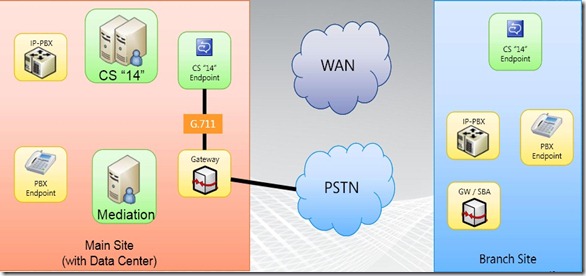
Second Scenario :
In this scenario the client is located in the branch site where there is no Lync Servers installed , when the client places a PSTN call it communicates directly with the IP-PBX over G.711 without the need for getting back to the Data Center pool mediation for transcoding. However this scenario is only applicable if your IP-PBX does support the new Media Bypass feature.
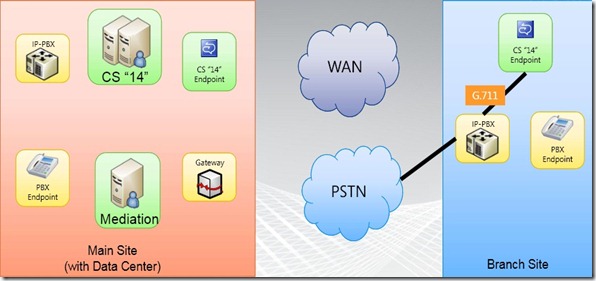
Third Scenario :
In this scenario we have two clients placing the call , one from the Data Center and the second is in Branch site. you will typically have this case in the international sites where you want to enable the least cost routing for international numbers. Lets say the Main Data Center is in US and the branch Site is in Egypt , and both Clients will dial the same number which is a US number.
So the first client who is in the US data center will communicate to the mediation server directly over G.711 , then the mediation will place the call through the Hosted SIP trunk to the PSTN also over G.711 since there is no local PBX available in the Data Center.
The Second Client who is in the Egypt branch site will dial the US number , the client will communication with the Mediation server place in the US Data center over RT Audio then the mediation will talk to the PSTN over G.711. In this second scenario we used RT Audio because it has got lots of features over the G.711 which consumes more bandwidth , RT Audio gives much better quality over WAN due to correction mechanisms and the ability to overcome lost packets.
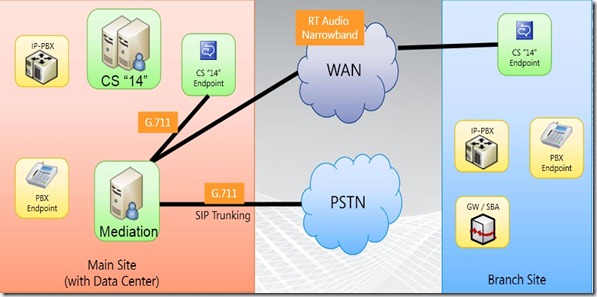
Forth Scenario :
In this scenario we have the same case like the last one , however we have also enabled Call Admission Control ( CAC ) which is a new great feature in Lync Server 2010. It allows call control over WAN to assure the accepted number of call over the allocated bandwidth and to refuse any extra calls over the allowed limit . What makes this CAC feature great also is not only to control calls over the WAN , but also to give alternate route for calls over the PSTN rather than using the WAN.
Ok let me explain it , the Client in the Egypt branch site is placing an international call to US number , so the client tries to place the call through the mediation placed in the US data center over the WAN , however due to WAN full usage and the CAC control ( call admission control ) so the call is not allowed to be placed over the WAN , however in spite of dropping the call we find that the client is redirected with alternate route to his local GW to place the call as international number from his PSTN gateway.
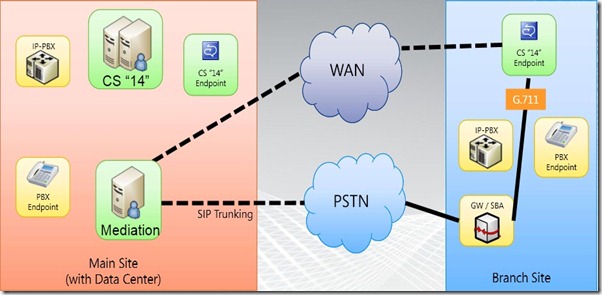
Fifth Scenario :
In this scenario the Client who is placed in the branch site places a call to a PBX legacy endpoint which is placed in the main site data center , this endpoint is connected to the IP PBX where this IP-PBX does not yet support direct Media bypass.
So the Client communicates over the WAN to the mediation server over RT Audio , then the call is routed after transcoding from the Mediation to the IP-PBX over G.711 , and finally the IP-PBX sends the call to the end point directly over G.711.
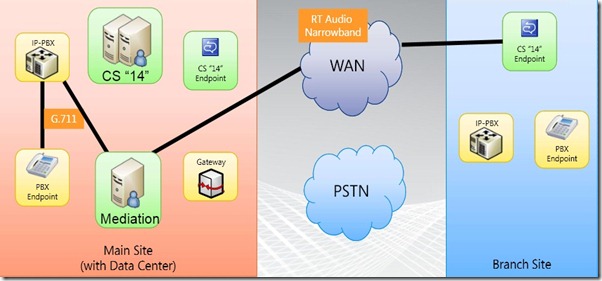
Csaba Vegso said
Hi,
Thanks for these call scenarios. It would be a good idea to cover SIP signaling as well. What about signaling in scenario 4? Is there a direct SIP signaling path between CS 14 Endpoint and GW/SBA? Does it mean that CS 14 Endpoint is able to use standard SIP signaling? Or GW/SBA is not a 3rd party GW but some Microsoft proprietary solution?
thanks again
tom said
Hi, I also did animation on media bypass which can be found at:
http://www.techtionary.com/lyncforum/lync-bypass/
In addition thousands of other tutorials can be found at http://techtionary.com
and a weekly newsletter at http://lyncforum.com
Cheers, TC
rv said
We have a mixed PBX environment. We would like to use the G729 codec in the Exchange/Lync environment? Is this possible with Lync?
Resources for getting up and running with Microsoft Lync Server 2010 « Jimblog said
[…] Microsoft Lync Server 2010 Media Bypass […]
AW said
Thanks for this, very informative and a really clear guide. Thanks again
real estate agent school said
These are in fact impressive ideas in concerning blogging.
You have touched some nice points here. Any way keep up wrinting.